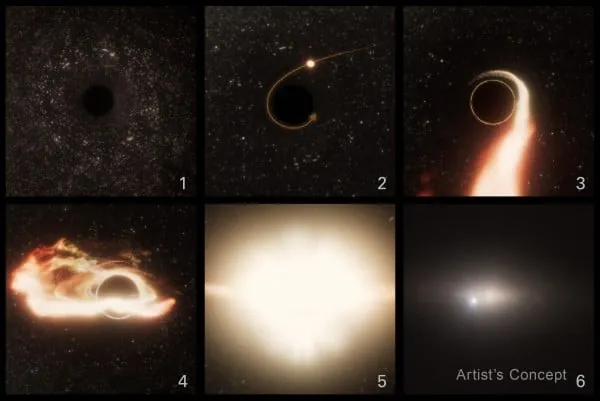
Astronomers Discover a Roaming Monster: A Massive Black Hole on the Move
2025-05-08
Author: Li
A Sci-Fi Discovery in the Abyss of Space
In an awe-inspiring reveal that feels like it’s straight out of a science fiction thriller, astronomers using NASA’s top telescopes have stumbled upon a colossal black hole, dubbed "Space Jaws," lurking in the dark expanse of space, a mind-blowing 600 million light-years away.
The Chilling Tale of AT2024tvd
This lurking menace was unveiled during an astonishing tidal disruption event (TDE), where a lone, unfortunate star was violently torn apart and consumed by the monstrous black hole, releasing a radiant burst of cosmic energy. Events like these serve as astronomical probes, illuminating the physics of black holes and exposing the conditions under which they unleash jets and winds while devouring stars.
The newly identified TDE, termed AT2024tvd, proved crucial for astronomers, helping them locate a wandering supermassive black hole with the aid of NASA’s Hubble Space Telescope. Remarkably, data from the Chandra X-ray Observatory and the Very Large Array telescope confirmed that this black hole is not situated at the center of its galaxy—a usual lair for supermassive black holes.
A Surprising Outlaw in the Galaxy
Weighing in at a staggering one million solar masses, this black hole's position is nothing short of astonishing. While most counterparts cling to the galaxy's center, this one hangs out 2,600 light-years away from a far grander supermassive black hole, which is a jaw-dropping 100 million times the mass of our Sun. This unusual setup challenges our traditional understanding of black hole behavior.
The Dance of Giants: Two Black Holes Coexist
In an unprecedented scenario, two supermassive black holes share the same galaxy but aren’t bound in a gravitational embrace. While the smaller black hole may eventually drift towards the central behemoth to merge, as of now, it drifts alone, further igniting discussions among scientists regarding the dynamics of black hole interactions.
Unraveling the Mystery: How Did It Get There?
Tidal disruption events occur when a black hole’s immense gravitational forces stretch an infalling star apart—often termed ‘spaghettification.’ The remnants then orbit the black hole, creating a spectacular display of glowing outflows. Yet, the question remains: how did this black hole end up off-center? Previous theories suggest it might have been ejected through interactions with other black holes, or it could be a relic from a merging galaxy more than a billion years ago.
A New Era of Discovery Awaits
With AT2024tvd as the first offset TDE observed by optical surveys, lead author Yuhan Yao of UC Berkeley enthuses that this opens up new pathways to uncover wandering black holes that previously eluded detection. The finding also paves the way for future research through advanced sky surveys, promising to revolutionize our understanding of the universe.
The Cosmic Flare that Gave It Away
Astronomers first detected the black hole’s presence when a stunning flare, comparable to a supernova, lit up the night sky. However, unlike a typical supernova explosion, this flare revealed elements like hydrogen and helium, providing clear evidence of the black hole’s voracious appetite for stars.
The Future of Cosmic Exploration
With specialized observatories like Hubble and Chandra joining forces to analyze such fleeting astronomical events, the future looks bright for uncovering the secrets of the cosmos. Upcoming telescopes, including the Vera C. Rubin Observatory and the Nancy Grace Roman Space Telescope, will further enhance our quest to pinpoint the origins and behaviors of these celestial creatures.
In the grand canvas of the universe, Hubble stands as a beacon of discovery, continuing to redefine our understanding of space and time. As it has for over 30 years, this marvel of science embodies international cooperation between NASA and the European Space Agency, forever pushing the boundaries of human knowledge.

 Brasil (PT)
Brasil (PT)
 Canada (EN)
Canada (EN)
 Chile (ES)
Chile (ES)
 Česko (CS)
Česko (CS)
 대한민국 (KO)
대한민국 (KO)
 España (ES)
España (ES)
 France (FR)
France (FR)
 Hong Kong (EN)
Hong Kong (EN)
 Italia (IT)
Italia (IT)
 日本 (JA)
日本 (JA)
 Magyarország (HU)
Magyarország (HU)
 Norge (NO)
Norge (NO)
 Polska (PL)
Polska (PL)
 Schweiz (DE)
Schweiz (DE)
 Singapore (EN)
Singapore (EN)
 Sverige (SV)
Sverige (SV)
 Suomi (FI)
Suomi (FI)
 Türkiye (TR)
Türkiye (TR)
 الإمارات العربية المتحدة (AR)
الإمارات العربية المتحدة (AR)